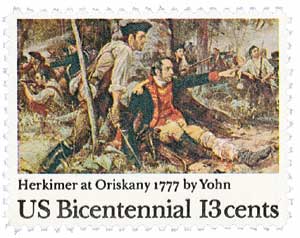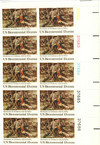
# 1722 - 1977 13c Herkimer at Oriskany
Bicentennial Series
American Victory At Oriskany

In the summer of 1777, British troops under Lieutenant Colonel Barry St. Leger traveled down New York’s Mohawk River Valley. When they encountered the American-held Fort Stanwix on August 2 the British began a 20-day siege.
Militia General Nicholas Herkimer (pictured seated on this stamp) was in the area and marched toward the fort to provide relief. However, St. Leger learned of Herkimer’s movements and planned a surprise attack. On the morning of August 6, Herkimer led his men through a nearby valley (in present-day Oriskany) where they were ambushed by a band of Loyalists and British-allied Indians. Early in the fighting, Herkimer was struck by a musketball that shattered his leg. His men carried him to a nearby beech tree and urged him to be removed from the battlefield. But Herkimer insisted “I will face the enemy” and sat calmy under the tree smoking his pipe, giving orders, and delivering words of encouragement.
Many of the untrained men in the rear of Herkimer’s column fled and were chased by the Native American fighters. Eventually, the American troops rallied and fought their way out of the valley. Around the same time, troops from Fort Stanwix raided nearby Indian camps for supplies. One of the camp’s guards set out for the Oriskany battlefield and informed his fellow warriors, who immediately left to protect their camp. With the larger Indian force leaving the battle, the Loyalist troops left as well, ending the Battle of Oriskany.
St. Leger considered Oriskany a victory because he prevented the American relief column from reaching Fort Stanwix. However, the American troops retained control of the battlefield. And the British-allied Indians – upset that their camps had been raided and possessions stolen – soon abandoned the siege of Fort Stanwix. Additionally, the battle sparked a civil war between factions of the Iroquois, who had fought on both sides at Oriskany. This was a major blow to the British forces.
Bicentennial Series
American Victory At Oriskany

In the summer of 1777, British troops under Lieutenant Colonel Barry St. Leger traveled down New York’s Mohawk River Valley. When they encountered the American-held Fort Stanwix on August 2 the British began a 20-day siege.
Militia General Nicholas Herkimer (pictured seated on this stamp) was in the area and marched toward the fort to provide relief. However, St. Leger learned of Herkimer’s movements and planned a surprise attack. On the morning of August 6, Herkimer led his men through a nearby valley (in present-day Oriskany) where they were ambushed by a band of Loyalists and British-allied Indians. Early in the fighting, Herkimer was struck by a musketball that shattered his leg. His men carried him to a nearby beech tree and urged him to be removed from the battlefield. But Herkimer insisted “I will face the enemy” and sat calmy under the tree smoking his pipe, giving orders, and delivering words of encouragement.
Many of the untrained men in the rear of Herkimer’s column fled and were chased by the Native American fighters. Eventually, the American troops rallied and fought their way out of the valley. Around the same time, troops from Fort Stanwix raided nearby Indian camps for supplies. One of the camp’s guards set out for the Oriskany battlefield and informed his fellow warriors, who immediately left to protect their camp. With the larger Indian force leaving the battle, the Loyalist troops left as well, ending the Battle of Oriskany.
St. Leger considered Oriskany a victory because he prevented the American relief column from reaching Fort Stanwix. However, the American troops retained control of the battlefield. And the British-allied Indians – upset that their camps had been raided and possessions stolen – soon abandoned the siege of Fort Stanwix. Additionally, the battle sparked a civil war between factions of the Iroquois, who had fought on both sides at Oriskany. This was a major blow to the British forces.











